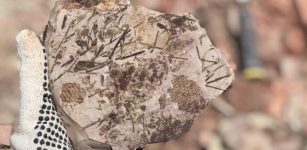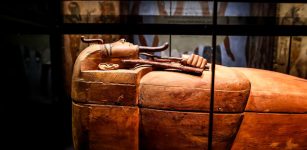Unique Belongings Of Bronze Age Warrior Offer Evidence Of Massive Violent Conflict In Europe
Conny Waters - AncientPages.com - Archaeologists have discovered a collection of 31 unusual objects that belonged to a Bronze Age warrior who died on the battlefield about 3,3000 years ago.
The artifacts were found at the river Tollense in Northern Germany and the site provides for the first time in Europe the evidence of a prehistoric battlefield.
Over 12,000 pieces of human bone have already been recovered from the valley and researchers have identified more than 140 individuals -- young adult males in good physical condition.
According to Dr. Joachim Krüger, from the University of Greifswald who led the diving team, the Bronze Age artifacts have been protected in the river from the looting, which inevitably followed fighting.
Researchers recovered dozens of personal objects, including decorative pins and metal knives, belonging to a Bronze Age warrior killed on a battlefield in Germany. Photo by V. Minkus/Antiquity
Among the unearthed artifacts were a decorated belt box, three dress pins and also arrow heads. Surprisingly scientists also found 31 objects (250g) tightly packed together, suggesting they were in a container made of wood or cloth that has since rotted away.
The items include a bronze tool with a birch handle, a knife, a chisel and fragments of bronze. Radiocarbon dating of the collection of objects demonstrates that the finds belong to the battlefield layer and they were probably the personal equipment of one of the victims.
Studies of the ancient items reveal that there was a massive violent conflict in the older Nordic Bronze Age (2000-1200 BC). In fact, recent evidence suggests that it is likely to have been on a large scale, clearly stretching beyond regional borders.
See also: More Archaeology News
Professor Thomas Terberger, from the Department of Pre- and Early History at the University of Göttingen, says, "This is the first discovery of personal belongings on a battlefield and it provides insights into the equipment of a warrior. The fragmented bronze was probably used as a form of early currency. The discovery of a new set of artifacts also provides us with clues about the origins of the men who fought in this battle and there is increasing evidence that at least some of the warriors originated in southern Central Europe."
Written by Conny Waters - AncientPages.com Staff Writer





















